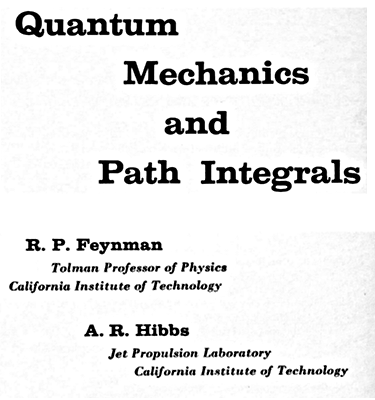\(\)

ファインマン経路積分の式 (6-98) は, ポテンシャル \(V\) が時間 \(t\) に依存しないときの「遷移振幅の2次の項」であった:
\begin{align}
e^{i(E_m t_2-E_n t_1)/\hbar}\lambda_{mn}^{(2)}&=\left(-\frac{i}{\hbar}\right)^{2}\sum_k V_{mk}V_{kn}
\int_0^{T}dt_4\,e^{i(E_m-E_k)t_4/\hbar}\int_0^{t_{4}}dt_3\,e^{i(E_k-E_n)t_3/\hbar}\\
&=\left(\frac{-i}{\hbar}\right)\sum_k V_{mk}V_{kn}\int_0^{T}dt_4\,e^{i\omega_{m k}t_4}
\frac{1-e^{i\omega_{k n}t_4}}{\hbar\omega_{k n}}\\
&=\sum_k \frac{V_{m k}V_{k n}}{\hbar\omega_{k n}}\left(\frac{1-e^{i\omega_{m k}T}}{\hbar\omega_{m k}}
-\frac{1-e^{i\omega_{m n}T}}{\hbar\omega_{m n}}\right)\\
&=\sum_k \frac{V_{m k}V_{k n}}{E_k-E_n}\left(\frac{e^{i(E_m-E_n)T/\hbar}-1}{E_m-E_n}
-\frac{e^{i(E_m-E_k)T/\hbar}-1}{E_m-E_k}\right)
\tag{6-98}
\end{align}
e^{i(E_m t_2-E_n t_1)/\hbar}\lambda_{mn}^{(2)}&=\left(-\frac{i}{\hbar}\right)^{2}\sum_k V_{mk}V_{kn}
\int_0^{T}dt_4\,e^{i(E_m-E_k)t_4/\hbar}\int_0^{t_{4}}dt_3\,e^{i(E_k-E_n)t_3/\hbar}\\
&=\left(\frac{-i}{\hbar}\right)\sum_k V_{mk}V_{kn}\int_0^{T}dt_4\,e^{i\omega_{m k}t_4}
\frac{1-e^{i\omega_{k n}t_4}}{\hbar\omega_{k n}}\\
&=\sum_k \frac{V_{m k}V_{k n}}{\hbar\omega_{k n}}\left(\frac{1-e^{i\omega_{m k}T}}{\hbar\omega_{m k}}
-\frac{1-e^{i\omega_{m n}T}}{\hbar\omega_{m n}}\right)\\
&=\sum_k \frac{V_{m k}V_{k n}}{E_k-E_n}\left(\frac{e^{i(E_m-E_n)T/\hbar}-1}{E_m-E_n}
-\frac{e^{i(E_m-E_k)T/\hbar}-1}{E_m-E_k}\right)
\tag{6-98}
\end{align}
「遷移振幅の2次の項 \(\lambda^{(2)}_{mn}\)」は, 問題 6-17 中の式 (6-74) に示されている:
\begin{equation}
\def\ket#1{|#1\rangle}
\def\bra#1{\langle#1|}
\lambda^{(2)}_{mn}=\left(-\frac{i}{\hbar}\right)^{2}\int_{t_1}^{t_2}dt_4\int_{t_1}^{t_4}dt_3\,\sum_{k}
e^{-iE_m(t_2-t_4)/\hbar}\,V_{mk}(t_4)\,e^{-iE_k(t_4-t_3)/\hbar}\,V_{kn}(t_3)\,e^{-iE_n(t_3-t_1)/\hbar}
\tag{6-74}
\end{equation}
\def\ket#1{|#1\rangle}
\def\bra#1{\langle#1|}
\lambda^{(2)}_{mn}=\left(-\frac{i}{\hbar}\right)^{2}\int_{t_1}^{t_2}dt_4\int_{t_1}^{t_4}dt_3\,\sum_{k}
e^{-iE_m(t_2-t_4)/\hbar}\,V_{mk}(t_4)\,e^{-iE_k(t_4-t_3)/\hbar}\,V_{kn}(t_3)\,e^{-iE_n(t_3-t_1)/\hbar}
\tag{6-74}
\end{equation}
また, \(c_{m}^{(1)}\) は次の式 (6-78) であった:
\begin{align}
c_{m}^{(1)}&\equiv e^{i(E_m t_2-E_n t_1)/\hbar}\,\lambda^{(1)}_{m n}\\
&=e^{i(E_m t_2-E_n t_1)/\hbar}\times\left(-\frac{i}{\hbar}\,e^{-i(E_m t_2-E_n t_1)/\hbar}
\int_{t_{1}}^{t_{2}}dt\,V_{m n}(t)\,e^{i(E_m-E_n)t/\hbar}\right)\\
&=-\frac{i}{\hbar}V_{m n}\int_{0}^{T}dt\,e^{i(E_m-E_n)T/\hbar}=V_{m n}\frac{1-e^{i(E_m-E_n)T/\hbar}}{E_m-E_n}
\tag{6-78}
\end{align}
c_{m}^{(1)}&\equiv e^{i(E_m t_2-E_n t_1)/\hbar}\,\lambda^{(1)}_{m n}\\
&=e^{i(E_m t_2-E_n t_1)/\hbar}\times\left(-\frac{i}{\hbar}\,e^{-i(E_m t_2-E_n t_1)/\hbar}
\int_{t_{1}}^{t_{2}}dt\,V_{m n}(t)\,e^{i(E_m-E_n)t/\hbar}\right)\\
&=-\frac{i}{\hbar}V_{m n}\int_{0}^{T}dt\,e^{i(E_m-E_n)T/\hbar}=V_{m n}\frac{1-e^{i(E_m-E_n)T/\hbar}}{E_m-E_n}
\tag{6-78}
\end{align}
更に, 「ダイソン級数の式」は次であった (J.J.Sakurai を参照のこと):
\begin{align}
\mathscr{U}_I(t)&=1-\frac{i}{\hbar}\int_{t_{0}}^{t}V_{I}(t_1)\mathscr{U}_I(t_1)\ dt_1
=1-\frac{i}{\hbar}\int_{t_{0}}^{t}V_{I}(t_1)\left[1-\frac{i}{\hbar}
\int_{t_{0}}^{t_{1}}V_{I}(t_{2})\mathscr{U}_I(t_{2})\ dt_{2}\right]\ dt_{1}\\
&=1-\frac{i}{\hbar}\int_{t_{0}}^{t}dt_{1}\ V_{I}(t_{1})+\left(\frac{-i}{\hbar}
\right)^{2}\int_{t_{0}}^{t}dt_{1}\int_{t_{0}}^{t_{1}}dt_{2}\ V_{I}(t_{1})V_{I}(t_{2})+\dotsb\\
&\quad +\left(\frac{-i}{\hbar}\right)^{n}\int_{t_{0}}^{t}dt_1\int_{t_{0}}^{t_1}dt_2 \dotsb
\int_{t_{0}}^{t_{(n-1)}}dt_{n}\ V_{I}(t_1)V_{I}(t_{2})\dotsb V_{I}(t_{n})
+\dotsb\\
&\equiv 1+\mathscr{U}_I^{(1)}(t)+\mathscr{U}_I^{(2)}(t)+\dotsb +\mathscr{U}_I^{(n)}(t)+\dotsb
\tag{1}
\end{align}
\mathscr{U}_I(t)&=1-\frac{i}{\hbar}\int_{t_{0}}^{t}V_{I}(t_1)\mathscr{U}_I(t_1)\ dt_1
=1-\frac{i}{\hbar}\int_{t_{0}}^{t}V_{I}(t_1)\left[1-\frac{i}{\hbar}
\int_{t_{0}}^{t_{1}}V_{I}(t_{2})\mathscr{U}_I(t_{2})\ dt_{2}\right]\ dt_{1}\\
&=1-\frac{i}{\hbar}\int_{t_{0}}^{t}dt_{1}\ V_{I}(t_{1})+\left(\frac{-i}{\hbar}
\right)^{2}\int_{t_{0}}^{t}dt_{1}\int_{t_{0}}^{t_{1}}dt_{2}\ V_{I}(t_{1})V_{I}(t_{2})+\dotsb\\
&\quad +\left(\frac{-i}{\hbar}\right)^{n}\int_{t_{0}}^{t}dt_1\int_{t_{0}}^{t_1}dt_2 \dotsb
\int_{t_{0}}^{t_{(n-1)}}dt_{n}\ V_{I}(t_1)V_{I}(t_{2})\dotsb V_{I}(t_{n})
+\dotsb\\
&\equiv 1+\mathscr{U}_I^{(1)}(t)+\mathscr{U}_I^{(2)}(t)+\dotsb +\mathscr{U}_I^{(n)}(t)+\dotsb
\tag{1}
\end{align}
式 (6-98) を得るには, 上式 (6-74) の \(\lambda_{mn}^{(2)}\) に \(e^{i(E_m t_2- E_n t_1)/\hbar}\) を掛け合わせ \(t_1=0,\,T=t_2-t_1\) とする.そして, 前式 (6-78) と「ダイソン級数の式」の第2項目を \(\mathscr{U}_{I}^{(2)}\) に利用する:
\begin{equation}
\mathscr{U}_{I}^{(2)}=\left(-\frac{i}{\hbar}\right)^{2}\int_{t_{0}}^{t}dt_{1}\int_{t_{0}}^{t_{1}}dt_{2}\ V_{I}(t_{1})V_{I}(t_{2})
\tag{2}
\end{equation}
\mathscr{U}_{I}^{(2)}=\left(-\frac{i}{\hbar}\right)^{2}\int_{t_{0}}^{t}dt_{1}\int_{t_{0}}^{t_{1}}dt_{2}\ V_{I}(t_{1})V_{I}(t_{2})
\tag{2}
\end{equation}
以上から,
\begin{align}
c_{m}^{(2)}&\equiv e^{i(E_m t_2 – E_n t_1)/\hbar}\,\lambda^{(2)}_{m n}
=\bra{m}\mathscr{U}_{I}^{(2)}(t_2,t_1)\ket{n}\\
&=\bra{m}\ \left(-\frac{i}{\hbar}\right)^{2}\int_{t_{1}}^{t_{2}}dt_4 \int_{t_{1}}^{t_{4}} dt_3\,V_{I}(t_4)\,V_{I}(t_3)\ \ket{n}\\
&=\left(-\frac{i}{\hbar}\right)^{2}\int_{t_{1}}^{t_{2}}dt_4 \int_{t_{1}}^{t_{4}} dt_3\,\bra{m}V_{I}(t_4)\left(\sum_{k}\ket{k}\bra{k}\right)V_{I}(t_3)\ket{n}\\
&=\sum_{k}\left(-\frac{i}{\hbar}\right)^{2}\int_{t_{1}}^{t_{2}}dt_4 \int_{t_{1}}^{t_{4}} dt_3\,\bra{m}V_{I}(t_4)\ket{k}
\bra{k}V_{I}(t_3)\ket{n}\\
&=\sum_{k}\left(-\frac{i}{\hbar}\right)^{2}\int_{t_{1}}^{t_{2}}dt_4\,e^{iE_m t_4/\hbar}\,V_{m k}\,e^{-iE_k t_4/\hbar}
\int_{t_{1}}^{t_{4}} dt_3\,e^{iE_k t_3/\hbar}\,V_{k n}\,e^{-iE_n t_3/\hbar}\\
&=\sum_{k} V_{m k}\,V_{k n}\left(-\frac{i}{\hbar}\right)\int_{0}^{T}dt_4\,e^{i(E_m-E_k)t_{4}/\hbar}\times
\left(-\frac{i}{\hbar}\right)\int_{0}^{t_{4}} dt_3\,e^{i(E_k-E_n)t_{3}/\hbar}\\
&=\sum_{k}V_{m k}\,V_{k n}\left(-\frac{i}{\hbar}\right)\int_{0}^{T}dt_4\,e^{i(E_m-E_k)t_{4}/\hbar}\times
\frac{1-e^{i(E_k-E_n)t_{4}/\hbar}}{E_k-E_n}\\
&=\sum_k \frac{V_{m k}V_{k n}}{E_k-E_n}\left[\left(-\frac{i}{\hbar}\right)\int_{0}^{T} e^{i(E_m-E_k)t_{4}/\hbar}\,dt_4
-\left(-\frac{i}{\hbar}\right)\int_{0}^{T} e^{i(E_m-E_n)t_{4}/\hbar}\,dt_4\right]\\
&=\sum_k \frac{V_{m k}V_{k n}}{E_k-E_n}\left[\frac{1-e^{i(E_m-E_k)T/\hbar}}{E_m-E_k}
-\frac{1-e^{i(E_m-E_n)T/\hbar}}{E_m-E_n}\right]
\tag{3}
\end{align}
c_{m}^{(2)}&\equiv e^{i(E_m t_2 – E_n t_1)/\hbar}\,\lambda^{(2)}_{m n}
=\bra{m}\mathscr{U}_{I}^{(2)}(t_2,t_1)\ket{n}\\
&=\bra{m}\ \left(-\frac{i}{\hbar}\right)^{2}\int_{t_{1}}^{t_{2}}dt_4 \int_{t_{1}}^{t_{4}} dt_3\,V_{I}(t_4)\,V_{I}(t_3)\ \ket{n}\\
&=\left(-\frac{i}{\hbar}\right)^{2}\int_{t_{1}}^{t_{2}}dt_4 \int_{t_{1}}^{t_{4}} dt_3\,\bra{m}V_{I}(t_4)\left(\sum_{k}\ket{k}\bra{k}\right)V_{I}(t_3)\ket{n}\\
&=\sum_{k}\left(-\frac{i}{\hbar}\right)^{2}\int_{t_{1}}^{t_{2}}dt_4 \int_{t_{1}}^{t_{4}} dt_3\,\bra{m}V_{I}(t_4)\ket{k}
\bra{k}V_{I}(t_3)\ket{n}\\
&=\sum_{k}\left(-\frac{i}{\hbar}\right)^{2}\int_{t_{1}}^{t_{2}}dt_4\,e^{iE_m t_4/\hbar}\,V_{m k}\,e^{-iE_k t_4/\hbar}
\int_{t_{1}}^{t_{4}} dt_3\,e^{iE_k t_3/\hbar}\,V_{k n}\,e^{-iE_n t_3/\hbar}\\
&=\sum_{k} V_{m k}\,V_{k n}\left(-\frac{i}{\hbar}\right)\int_{0}^{T}dt_4\,e^{i(E_m-E_k)t_{4}/\hbar}\times
\left(-\frac{i}{\hbar}\right)\int_{0}^{t_{4}} dt_3\,e^{i(E_k-E_n)t_{3}/\hbar}\\
&=\sum_{k}V_{m k}\,V_{k n}\left(-\frac{i}{\hbar}\right)\int_{0}^{T}dt_4\,e^{i(E_m-E_k)t_{4}/\hbar}\times
\frac{1-e^{i(E_k-E_n)t_{4}/\hbar}}{E_k-E_n}\\
&=\sum_k \frac{V_{m k}V_{k n}}{E_k-E_n}\left[\left(-\frac{i}{\hbar}\right)\int_{0}^{T} e^{i(E_m-E_k)t_{4}/\hbar}\,dt_4
-\left(-\frac{i}{\hbar}\right)\int_{0}^{T} e^{i(E_m-E_n)t_{4}/\hbar}\,dt_4\right]\\
&=\sum_k \frac{V_{m k}V_{k n}}{E_k-E_n}\left[\frac{1-e^{i(E_m-E_k)T/\hbar}}{E_m-E_k}
-\frac{1-e^{i(E_m-E_n)T/\hbar}}{E_m-E_n}\right]
\tag{3}
\end{align}
上式で, 鍵カッコ内の項の符号を変えたものが式 (6-98) である:
\begin{equation}
e^{i(E_m t_2 – E_n t_1)/\hbar}\,\lambda^{(2)}_{m n}
=\sum_k \frac{V_{m k}V_{k n}}{E_k-E_n}\left(\frac{e^{i(E_m-E_n)T/\hbar}-1}{E_m-E_n}
-\frac{e^{i(E_m-E_k)T/\hbar}-1}{E_m-E_k}\right)
\tag{6-98}
\end{equation}
e^{i(E_m t_2 – E_n t_1)/\hbar}\,\lambda^{(2)}_{m n}
=\sum_k \frac{V_{m k}V_{k n}}{E_k-E_n}\left(\frac{e^{i(E_m-E_n)T/\hbar}-1}{E_m-E_n}
-\frac{e^{i(E_m-E_k)T/\hbar}-1}{E_m-E_k}\right)
\tag{6-98}
\end{equation}
この式 (6-98) 以降の原書の説明文は次のようになっている:
The first of the two terms in the last factor of this result has the same time dependence as we have seen in our first-order result. Therefore if the other term is neglected for a moment, we see that the net result would again be to make transitions to states where \(E_m=E_n\), with a probability proportional to \(T\). The probability per unit time is of the same form as Eq. (6-86) but with \(M_{n\to m}\) now given by
\begin{equation}
M_{n\to m}=\sum_{k} \frac{V_{m k}V_{k n}}{E_{k}-E_{n}}
\tag{6-99}
\end{equation}
M_{n\to m}=\sum_{k} \frac{V_{m k}V_{k n}}{E_{k}-E_{n}}
\tag{6-99}
\end{equation}
If we assume that the states lie in a continuum, the sum becomes an integral. Equation (6-99) is correct in the circumstance that it is impossible to go by first-order transition, impossible not only to the state \(m\) but alse to any state \(k\) of the same energy as the initial state. Under these circumstances \(V_{k n}=0\) for states such that \(E_{k}=E_{n}\). Then the second term in Eq. (6-98) is never large; for it cannot be large unless \(E_{n}-E_{k}\) is nearly zero, and then \(V_{k n}\) in the numerator is zero. All the effects come from the first term, and Eq. (6-99) is correct. Furthermore, in the sum over \(k\) in Eq. (6-98) there is no ambiguity at the pole where \(E_{k}=E_{m}\); for the numerator vanishes at this same value of \(E_{k}\).
しかしながら, この文章の内容を考えると, 上記の青文字部分は次のように変更されるべきではないかと思われる !? :
Then the second term in Eq. (6-98) is never large; for it cannot be large unless \(E_{m}-E_{k}\) is nearly zero, and then \(V_{m k}\) in the numerator is zero. All the effects come from the first term, and Eq. (6-99) is correct.

